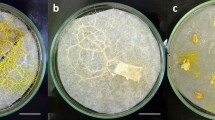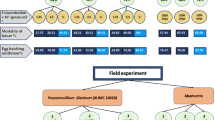Abstract
The survival of Neozygites cf. floridana (Weiser and Muma) as dry hyphal bodies in mummified cassava green mites, Mononychellus tanajoa (Bondar), at 5.0% RH in the dark was affected by storage temperature. Survival of the fungus in mummies kept at 24±1.0°C could be demonstrated for 6–7 months. When stored at 4°C, the fungus sporulated from 90% of the mummies liberating an average of 186.9 primary conidia per mummy even after a storage period of 16 months, when the experiment was terminated. The temperature, humidity and light condition significantly affected the viability of primary conidia. The percent viability across all factors dropped from 98.4% after 0 h (beginning of the experiment) to 23.4% after a 1 h exposure to the conditions tested. Lower temperatures maintained higher viabilities with 86.3% of the conidia surviving after 18 h at 18°C, whereas almost all conidia died after 12 h at 33°C. Conidia survived less than 1 h when exposed to SDs (saturation deficit) of 2.0 mm Hg or higher at any tested temperature.
Similar content being viewed by others
References
Benz, G. 1987. Environment. In Epizootiology of insect diseases, J.R., Fuxa and Y., Tanada (eds), pp. 177–214. John Wiley and Sons, New York.
Carner, G.R. 1976. A description of the life cycle of Entomophthora sp. in the two spotted spider mite. J. Invertebr. Pathol. 28: 245–254.
Clerk, G. C. and Madelin, M. F. 1965. The longevity of conidia of three insect-parasitising hyphomycetes. Trans. Br. Mycol. Soc. 48: 193–209.
Kenneth, R., Wallis, G., Gerson, U. and Plautt, H.N. 1972. Observations and experiments on Triplosporium floridanum (Entomophthorales) attacking spider mites in Israel. J. Invertebr. Pathol. 19: 366–369.
Nemoto, H. and Aoki, J. 1975. Entomophthora floridana (Entomophthorales: Entomophthoraceae) attacking the sugi spider mites, Oligonychus hondoensis (Acari: Tetranychidae) in Japan. Appl. Entomol. Zool. 10: 90–95.
Newmann, G.G. and Carner, G.R. 1975. Factors affecting the spore form of Entomophthora gammae. J. Invertebr. Pathol. 26: 29–34.
Page, R.M., Sherf, A.F. and Morgan, T.L. 1947. The effect of temperature and relative humidity on the longevity of the conidia of Helminthosporium oryzae. Mycologia 39: 158–164.
Pell, J.K. and Wilding, N. 1992. The survival of Zoophthora radicans (Zygomycetes: Entomophthorales) isolates as hyphal bodies in mummified larvae of Plutella xylostella (Lepidoptera: Yponomeutidae). Entomophaga 37: 649–654.
SAS Institute, Inc. 1988. SAS/STATtm User's Guide. Release 6.03, ed. SAS Institute, Cary, N.C.
Sawyer, W.H. 1931. Studies on the morphology and development of an insect destroying fungus, Entomophthora sphaerosperma. Mycologia 23: 411–432.
Shimazu, M. 1979. Resting spore formation of Entomophthora sphaerosperma (Entomophthorales: Entomophthoraceae) in the brown planthopper, Nilaparvata lugens (Stahl) (Homoptera: Delphacidae). Appl. Entomol. Zool. 14: 383–388.
Shimazu, M. and Soper, R.S. 1986. Pathogenicity and sporulation of Entomophaga maimaiga (Entomophthorales: Entomophthoraceae) on larvae on the gypsy moth, Lymantria dispar (Lepidoptera: Lymantriidae). Appl. Entomol. Zool. 21: 589–596.
Steinkraus, D. C. and Slaymaker, P. H. 1994. Effect of temperature and humidity on formation, germination and infectivity of conidia of Neozygites fresenii (Zygomycetes: Neozygitaceae) from Aphis gossypii (Homoptera: Aphididae). J. Invertebr. Pathol. 64: 130–137.
Tanada, Y. and Fuxa, J.R. 1987. The pathogen population. In Epizootiology of insect diseases, J.R., Fuxa and Y., Tanada (eds), pp. 113–157. John Wiley and Sons, New York.
Tyrrell, D. 1988. Survival of Entomophaga aulicae in dried insect larvae. J. Invertebr. Pathol. 52: 187–188.
Watanabe, H. 1987. The host population. In Epizootiology of insect diseases, J.R., Fuxa and Y., Tanada (eds), pp. 71–112. John Wiley and Sons, New York.
Wilding, N. 1973. The survival of Entomophthora spp. in mummified aphids at different temperatures and humidities. J. Invertebr. Pathol. 21: 309–311.
Wilding, N. and Lauckner, F.B. 1974. Entomophthora infecting wheat bulb fly at Rothamstead, Hertfordshire, 1967–71. Ann. Appl. Biol. 76: 161–170.
Zar, J.H. 1984. Biostatistical Analysis. Prentice-Hall, Englewood Cliffs NJ.
Author information
Authors and Affiliations
Rights and permissions
About this article
Cite this article
Oduor, G.I., Yaninek, J.S., van der Geest, L.P.S. et al. Survival of Neozygites cf. floridana (Zygomycetes: Entomophthorales) in mummified cassava green mites and the viability of its primary conidia. Exp Appl Acarol 19, 479–488 (1995). https://doi.org/10.1007/BF00052916
Issue Date:
DOI: https://doi.org/10.1007/BF00052916




